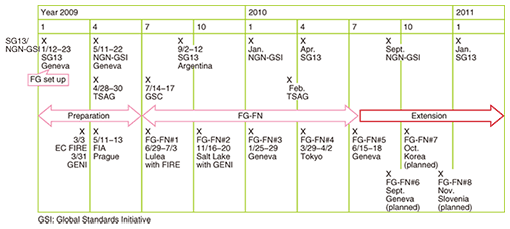 |
|||||||
|
|
|||||||
|
Global Standardization Activities Vol. 8, No. 9, pp. 25–27, Sept. 2010. https://doi.org/10.53829/ntr201009gls Overview and Status of Focus Group on Future Networks at ITU-TAbstractThe Focus Group on Future Networks (FG-FN) was established by Study Group 13 (SG13) of the International Telecommunication Union, Telecommunication Standardization Sector (ITU-T) in 2009. Its main role is to share discussions on future networks and ensure a global common understanding about them. This article describes the current status and activities of FG-FN.
1. Focus Group on Future NetworksITU-T SG13 (Study Group 13 of the International Telecommunication Union, Telecommunication Standardization Sector), which has been working on standardization for Next Generation Networks (NGNs), expressed its intention to conduct an initial study of Future Networks (FNs). At a meeting in January 2009, the study group agreed to establish a new focus group (FG) as the main body for the study. The FG¡Çs scope and objectives are listed below [1]. (1) Scope – collect and identify visions of FNs, based on new technologies, – assess the interactions between FNs and new services, – familiarize ITU-T and standardization communities with emerging attributes of FNs, and – encourage collaboration between ITU-T and FN communities. (2) Objectives – gather new ideas relevant to FNs and identify potential study areas on FNs, – describe visions of FNs, – identify a timeframe of FNs, – identify potential impacts on standards development, and – suggest future ITU-T study items and related actions. By collaborating with the worldwide FN communities (e.g., research institutes, forums, and academia), the FG has been collecting various information related to FN research activities. FG-FN held its first meeting in June 2009. On the basis of the information collected, we have discussed the vision, merits, and high-level definitions of FNs, which will be helpful for developing ITU-T Recommendations for FNs. Aiming at effective information sharing, the FG has held some meetings with other bodies related to FNs. 2. Activities of FG-FNThe FG has held five official meetings to date, as shown in Fig. 1. In the first official meeting (June–July 2009 in Lulea, Sweden), we had a joint discussion with project members of the European research body FIRE (Future Internet Research and Experiment). The second official meeting (November 2009 in Salt Lake City, USA) was held at the same time and location as a meeting of the GENI (Global Environment for Network Innovations) project. This enabled us to have meaningful discussions with several researchers working on FNs in the USA. Both projects were established for building and managing test-beds for research and experiments on novel network architectures and key technologies for FNs [2].
Initially, the majority of FG members comprised attendees from Japan and Korea. Since the third official meeting, however, the number of attendees from other countries has gradually been increasing. Although most of the contributions to date have also come from Japan and Korea, the FG has invited Professor Alex Galis to serve as a Vice Chairman of the group. He is a Visiting Professor at University College London and is expected to act as an intermediary between the FG and some European research communities. The lifetime of an FG in ITU-T is normally limited to one year. As such, FG-FN had been scheduled to complete its role by the end of June 2010. However, at the official meeting of SG13 in April 2010, an extension was granted to enable descriptions in the output documents to be improved and more information about FNs to be collected. Therefore, the FG will continue its activities until the end of 2010. As of July 2010, three additional official meetings are scheduled, as shown in Fig. 1. The FG¡Çs output documents (called Deliverables) will be submitted at the regular SG13 meeting in January 2011. 3. Discussions about FNs in the FGIn the current discussion, the FG considers 2015–2020 to be the target timeframe for FNs. The main topics being discussed in the FG are FN visions, concepts, and requirements. In addition, we are working on the development of key technologies for FNs. We are currently incorporating the outputs of these discussions into the editing of the FG¡Çs main deliverable, which is entitled “Future Networks: Design Goals and Promising Technologies”. To address certain key areas of technology, such as network virtualization and energy saving in networks, we are preparing “Framework Documents”, which include considerable information about important technologies, including basic definitions, problem statements, and applications. Since the beginning stage of the FG, we have maintained communication with the worldwide FN communities. After accumulating information about their research activities and associated contributions about project descriptions, we compiled them into a document entitled “Project Descriptions”. A glossary will be developed for this and other output documents. The FG¡Çs planned output documents (deliverables) are listed in Table 1.
4. Future workFG-FN¡Çs lifetime has been extended by six months. All documents (deliverables) expected to be output are now being discussed. The FG is focusing mainly on completing a substantial vision-related deliverable. The other deliverables will be improved during the course of the three remaining official meetings scheduled. After FG-FN concludes its work, further studies and discussions about FNs will be taken over by SG13 (Question 21). 5. ConclusionThis article presented a brief overview of FG-FN and its current activities. As a member of this FG, NTT Laboratories is making contributions that should aid in achieving FN standardization in the future. References
|
|||||||











